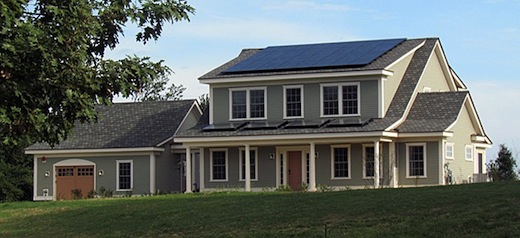
It has now been a year since the Net-Zero Energy Residential Test Facility (NZERTF) in Washington DC has been built and its energy harvesting capabilities began to be monitored. The home was built on the campus at the National Institute of Standards and Technology (NIST), where scientists and researchers conducted a computer simulation that replicated the energy consumption of a family of four. The results showed the home to be a success, since after a year the home generated 13,577 kWh of energy. This is about 491 kWh more than was needed.
The test home measures 2,700 square feet (252 sq m) and is a two-story home, which was built to resemble a regular home. The home is equipped with a rooftop mounted solar panel array, which was able to harvest enough energy to create the surplus despite being hindered by very bad weather during the winter. For about 38 days the 32 photovoltaic panels were covered by snow yet still managed to harvest enough energy to power the home and create the surplus.
The energy expenditure was calculated and monitored as though a typical American family of four lived in the house, which includes showering, charging gadgets and laptops, watching TV and so on. According to the researchers, the most important factor that led to the success of the experiment was the super efficient thermal envelope. They designed it so it nearly eliminated unwanted air infiltration while the insulation level in the walls and roof was also doubled, effectively decreasing the heating and cooling loads of the home. The home also features a geothermal system to control the heating and cooling loads.


While the findings proved to be a success, fitting a house with the type of technology that led to it would cost around $162,700. The benefit is an electricity savings of $4,373 per year, but the starting investment is still more than an average family can afford. The researchers will continue this experiment, with a focus on how the energy efficiency can be improved further and how the difference between the investment costs and savings can be lessened.
Related Articles on JetsonGreen.com:
A Zero Net Energy Prototype House Built in California
Florida Contractor Builds the First Luxury Net Zero Energy Home
Light Filled Net Zero Home

Leave a Reply
You must be logged in to post a comment.